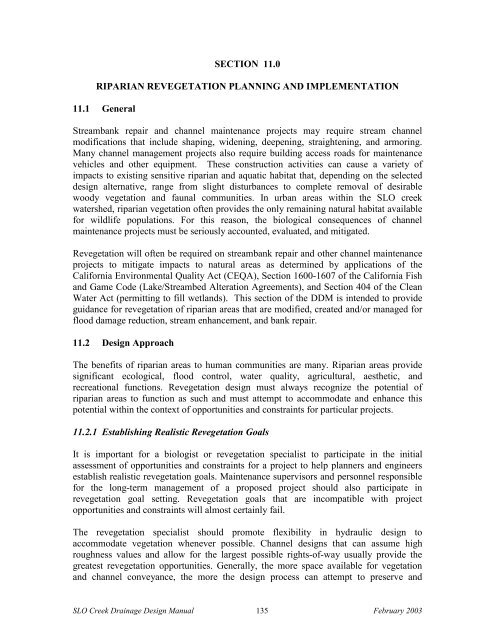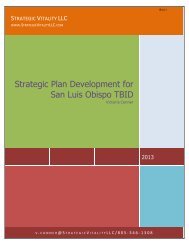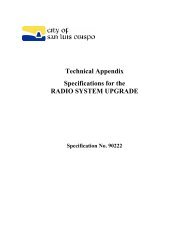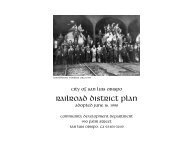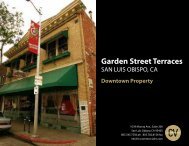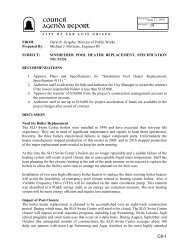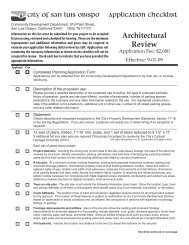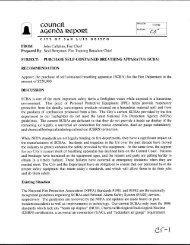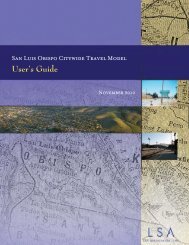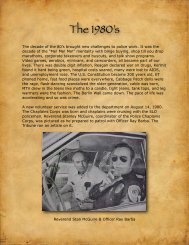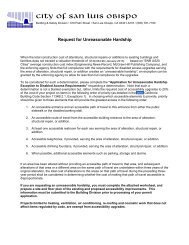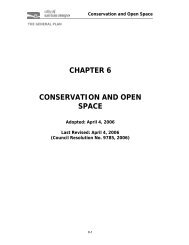Drainage Design Manual - the City of San Luis Obispo
Drainage Design Manual - the City of San Luis Obispo
Drainage Design Manual - the City of San Luis Obispo
Create successful ePaper yourself
Turn your PDF publications into a flip-book with our unique Google optimized e-Paper software.
SECTION 11.0RIPARIAN REVEGETATION PLANNING AND IMPLEMENTATION11.1 GeneralStreambank repair and channel maintenance projects may require stream channelmodifications that include shaping, widening, deepening, straightening, and armoring.Many channel management projects also require building access roads for maintenancevehicles and o<strong>the</strong>r equipment. These construction activities can cause a variety <strong>of</strong>impacts to existing sensitive riparian and aquatic habitat that, depending on <strong>the</strong> selecteddesign alternative, range from slight disturbances to complete removal <strong>of</strong> desirablewoody vegetation and faunal communities. In urban areas within <strong>the</strong> SLO creekwatershed, riparian vegetation <strong>of</strong>ten provides <strong>the</strong> only remaining natural habitat availablefor wildlife populations. For this reason, <strong>the</strong> biological consequences <strong>of</strong> channelmaintenance projects must be seriously accounted, evaluated, and mitigated.Revegetation will <strong>of</strong>ten be required on streambank repair and o<strong>the</strong>r channel maintenanceprojects to mitigate impacts to natural areas as determined by applications <strong>of</strong> <strong>the</strong>California Environmental Quality Act (CEQA), Section 1600-1607 <strong>of</strong> <strong>the</strong> California Fishand Game Code (Lake/Streambed Alteration Agreements), and Section 404 <strong>of</strong> <strong>the</strong> CleanWater Act (permitting to fill wetlands). This section <strong>of</strong> <strong>the</strong> DDM is intended to provideguidance for revegetation <strong>of</strong> riparian areas that are modified, created and/or managed forflood damage reduction, stream enhancement, and bank repair.11.2 <strong>Design</strong> ApproachThe benefits <strong>of</strong> riparian areas to human communities are many. Riparian areas providesignificant ecological, flood control, water quality, agricultural, aes<strong>the</strong>tic, andrecreational functions. Revegetation design must always recognize <strong>the</strong> potential <strong>of</strong>riparian areas to function as such and must attempt to accommodate and enhance thispotential within <strong>the</strong> context <strong>of</strong> opportunities and constraints for particular projects.11.2.1 Establishing Realistic Revegetation GoalsIt is important for a biologist or revegetation specialist to participate in <strong>the</strong> initialassessment <strong>of</strong> opportunities and constraints for a project to help planners and engineersestablish realistic revegetation goals. Maintenance supervisors and personnel responsiblefor <strong>the</strong> long-term management <strong>of</strong> a proposed project should also participate inrevegetation goal setting. Revegetation goals that are incompatible with projectopportunities and constraints will almost certainly fail.The revegetation specialist should promote flexibility in hydraulic design toaccommodate vegetation whenever possible. Channel designs that can assume highroughness values and allow for <strong>the</strong> largest possible rights-<strong>of</strong>-way usually provide <strong>the</strong>greatest revegetation opportunities. Generally, <strong>the</strong> more space available for vegetationand channel conveyance, <strong>the</strong> more <strong>the</strong> design process can attempt to preserve andSLO Creek <strong>Drainage</strong> <strong>Design</strong> <strong>Manual</strong> 135 February 2003


